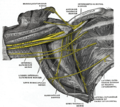This article includes a list of general references, but it lacks sufficient corresponding inline citations .(March 2013) |
| Brachial artery | |
|---|---|
 The brachial artery | |
 Right upper limb, anterior view, brachial artery and elbow. | |
| Details | |
| Source | Axillary artery |
| Branches | Profunda brachii Superior ulnar collateral artery Inferior ulnar collateral artery Radial artery Ulnar artery |
| Vein | Brachial vein |
| Supplies | Biceps brachii muscle, triceps brachii muscle, coracobrachialis |
| Identifiers | |
| Latin | arteria brachialis |
| MeSH | D001916 |
| TA98 | A12.2.09.018 |
| TA2 | 4632 |
| FMA | 22689 |
| Anatomical terminology | |
The brachial artery is the major blood vessel of the (upper) arm. It is the continuation of the axillary artery beyond the lower margin of teres major muscle. It continues down the ventral surface of the arm until it reaches the cubital fossa at the elbow. It then divides into the radial and ulnar arteries which run down the forearm. [1] [2] In some individuals, the bifurcation occurs much earlier and the ulnar and radial arteries extend through the upper arm. The pulse of the brachial artery is palpable on the anterior aspect of the elbow, medial to the tendon of the biceps, and, with the use of a stethoscope and sphygmomanometer (blood pressure cuff), often used to measure the blood pressure. [1]
Contents
The brachial artery is closely related to the median nerve; in proximal regions, the median nerve is immediately lateral to the brachial artery. [3] Distally, the median nerve crosses the medial side of the brachial artery and lies anterior to the elbow joint. [1] [4]









